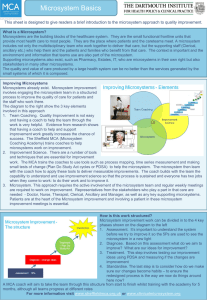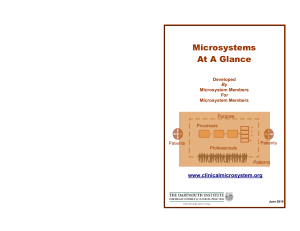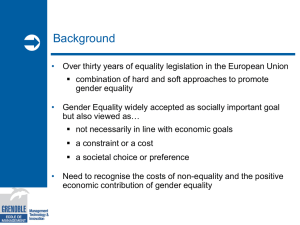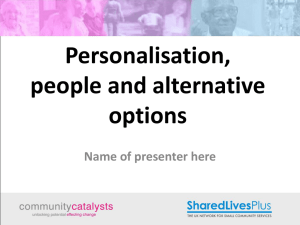M3 Matrix: Micro-Meso
advertisement
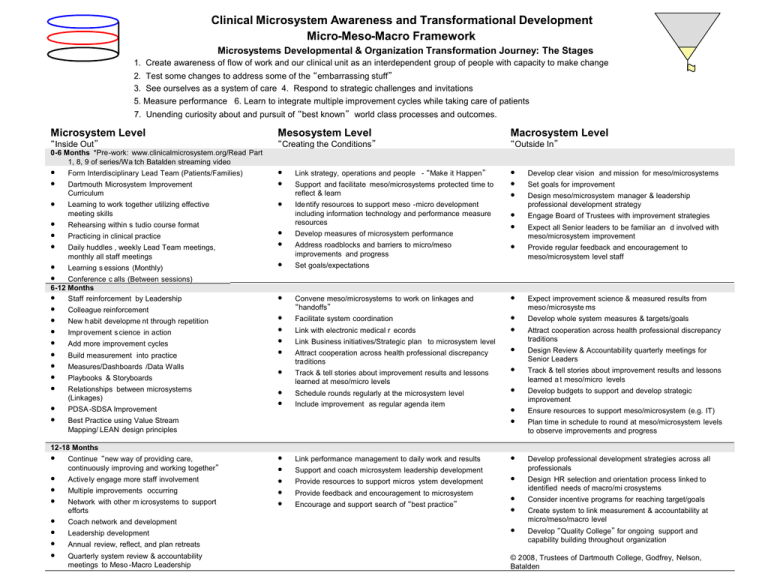
Clinical Microsystem Awareness and Transformational Development Micro-Meso-Macro Framework Microsystems Developmental & Organization Transformation Journey: The Stages 1. Create awareness of flow of work and our clinical unit as an interdependent group of people with capacity to make change 2. Test some changes to address some of the “embarrassing stuff” 3. See ourselves as a system of care 4. Respond to strategic challenges and invitations 5. Measure performance 6. Learn to integrate multiple improvement cycles while taking care of patients 7. Unending curiosity about and pursuit of “best known” world class processes and outcomes. Microsystem Level Mesosystem Level Macrosystem Level “Inside Out” “Creating the Conditions” “Outside In” 0-6 Months *Pre-work: www.clinicalmicrosystem.org/Read Part 1, 8, 9 of series/Wa tch Batalden streaming video Form Interdisciplinary Lead Team (Patients/Families) Dartmouth Microsystem Improvement Curriculum Learning to work together utilizing effective meeting skills Rehearsing within s tudio course format Practicing in clinical practice Daily huddles , weekly Lead Team meetings, monthly all staff meetings Learning s essions (Monthly) Conference c alls (Between sessions) 6-12 Months Staff reinforcement by Leadership Colleague reinforcement New habit developme nt through repetition Improvement s cience in action Add more improvement cycles Build measurement into practice Measures/Dashboards /Data Walls Playbooks & Storyboards Relationships between microsystems (Linkages) PDSA -SDSA Improvement Support and facilitate meso/microsystems protected time to reflect & learn Identify resources to support meso -micro development including information technology and performance measure resources Develop measures of microsystem performance Address roadblocks and barriers to micro/meso improvements and progress Continue “new way of providing care, continuously improving and working together” Active ly engage more staff involvement Multiple improvements occurring Network with other m icrosystems to support efforts Coach network and development Leadership development Annual review, reflect, and plan retreats Quarterly system review & accountability meetings to Meso -Macro Leadership Develop clear vision and mission for meso/microsystems Set goals for improvement Design meso/microsystem manager & leadership professional development strategy Engage Board of Trustees with improvement strategies Expect all Senior leaders to be familiar an d involved with meso/microsystem improvement Provide regular feedback and encouragement to meso/microsystem level staff Set goals/expectations Convene meso/microsystems to work on linkages and “handoffs” Facilitate system coordination Link with electronic medical r ecords Link Business initiatives/Strategic plan to microsystem level Attract cooperation across health professional discrepancy traditions Track & tell stories about improvement results and lessons learned at meso/micro levels Schedule rounds regularly at the microsystem level Include improvement as regular agenda item Best Practice using Value Stream Mapping/ LEAN design principles 12-18 Months Link strategy, operations and people - “Make it Happen” Link performance management to daily work and results Support and coach microsystem leadership development Provide resources to support micros ystem development Provide feedback and encouragement to microsystem Encourage and support search of “best practice” Expect improvement science & measured results from meso/microsyste ms Develop whole system measures & targets/goals Attract cooperation across health professional discrepancy traditions Design Review & Accountability quarterly meetings for Senior Leaders Track & tell stories about improvement results and lessons learned a t meso/micro levels Develop budgets to support and develop strategic improvement Ensure resources to support meso/microsystem (e.g. IT) Plan time in schedule to round at meso/microsystem levels to observe improvements and progress Develop professional development strategies across all professionals Design HR selection and orientation process linked to identified needs of macro/mi crosystems Consider incentive programs for reaching target/goals Create system to link measurement & accountability at micro/meso/macro level Develop “Quality College” for ongoing support and capability building throughout organization © 2008, Trustees of Dartmouth College, Godfrey, Nelson, Batalden Some Questions For Senior Leaders to Consider At All Levels Macrosystem leader 1. How does this work bring help / value to the patients? What stories illustrate that? 2. What are the values that are part of the everyday work? 3. What helps people grow, develop and become better professionals here? 4. What helps people personally engage the never ending safeguarding and improving of patient care? 5. What connects this whole place—from the patient and those working directly with the patient down to the leaders of the organization? 6. What helps the processes of inquiry, learning and change within, between and across microsystems and mesosystems? 7. What helps people do their own work and improve patient outcomes—year after year? 8. What might be possible? What are some of the current limits we face? 9. What are some of the most relevant external forces for this micro-meso-macrosystem? 10. Do you have the measurements & feedback necessary to make it easy for you to monitor and improve the quality of your performance? 11. Are you treated with dignity and respect everyday by everyone you encounter, without any regard for hierarchy? 12. Are you given the opportunity and tools that you need to make a contribution that gives meaning to your life? 13. Does someone notice when you’ve done the job you do? 14. As you think about what you do and your ability to change it—what gains have been made, as you think about now in comparison with the past? 15. How do you actually do what you do? What changes have you been able to make? What changes are you working on now? 16. What changes that you’ve tried haven’t worked? 17. Do people feel compelled to regularly justify or rationalize things that happen around here? Mesosystem leader How do the “organization’s messages” move? How does the “macro” strategy connect to the microsystems? What helps adapt, respond to it? What are the microsystems doing about Muda—wasted activity Mura—irregular work flow Muri—stress, overwork How do the microsystems link strategy, operations and people needed for successful execution? What are the helpful cultural supports for measurably improving the quality, reliability and value of care in the microsystem(s)? What are the cultural changes required to measurably improve the quality, reliability and value of care at the frontlines? What is the process for identifying, orienting the microsystem leaders…for helping set their expectations…for reviewing their performance and for holding the clinical microsystem accountable for its performance? What about my own style of work speaks more convincingly than my words about the desired “way” of work? What helps maintain a steadfast focus on “improved patient care outcomes by more reliable and more efficient systems that are regularly reflected on and redesigned?” Microsystem leader How does this microsystem work? Who does what to whom? What technology is part of what you regularly do? What is the main or core process of the way work gets done here? How does it vary? What are some of the limitations you encounter as you try to do what you do for patients? When you want to change the clinical care because of some new knowledge, how does that work? What are the helpful measures you regularly use here? How are those measures analyzed and displayed? What are the things people honor as “traditions” around here? If you had to single out a few things that really contribute to and “mark” the identity of this clinical microsystem, what might you point to? What do people ask questions about around here? Who asks? Who gets asked? What does it take to make things happen around here? When did it work well? Who did what? How does information & information technology get integrated into the daily work and new initiatives around here? When you add new people here, how do you go about it? How are things “noticed” around here? If you to point to an example of “respect” amongst yourselves here, what might you point to? How do the leaders get involved in change here? How are patients brought into the daily workings and improvement of the clinical microsystem? Do people have a good idea of each others’ work? How is that brought about? Do you discuss the common patterns of the way you work? And the ways you test changes in them?


